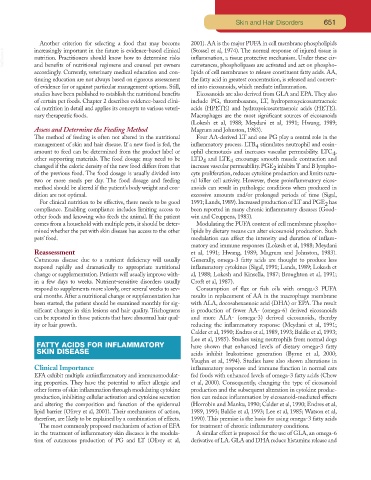Page 629 - Small Animal Clinical Nutrition 5th Edition
P. 629
Skin and Hair Disorders 651
Another criterion for selecting a food that may become 2001). AA is the major PUFA in cell membrane phospholipids
VetBooks.ir increasingly important in the future is evidence-based clinical (Stossel et al, 1974). The normal response of injured tissue is
inflammation, a tissue protective mechanism. Under these cir-
nutrition. Practitioners should know how to determine risks
cumstances, phospholipases are activated and act on phospho-
and benefits of nutritional regimens and counsel pet owners
accordingly. Currently, veterinary medical education and con- lipids of cell membranes to release constituent fatty acids. AA,
tinuing education are not always based on rigorous assessment the fatty acid in greatest concentration, is released and convert-
of evidence for or against particular management options. Still, ed into eicosanoids, which mediate inflammation.
studies have been published to establish the nutritional benefits Eicosanoids are also derived from GLA and EPA.They also
of certain pet foods. Chapter 2 describes evidence-based clini- include PG, thromboxanes, LT, hydroperoxyeicosatetraenoic
cal nutrition in detail and applies its concepts to various veteri- acids (HPETE) and hydroxyeicosatetraenoic acids (HETE).
nary therapeutic foods. Macrophages are the most significant sources of eicosanoids
(Lokesh et al, 1988; Meydani et al, 1991; Hwang, 1989;
Assess and Determine the Feeding Method Magrum and Johnston, 1983).
The method of feeding is often not altered in the nutritional Four AA-derived LT and one PG play a central role in the
management of skin and hair disease. If a new food is fed, the inflammatory process. LTB stimulates neutrophil and eosin-
4
amount to feed can be determined from the product label or ophil chemotaxis and increases vascular permeability. LTC ,
4
other supporting materials. The food dosage may need to be LTD and LTE encourage smooth muscle contraction and
4
4
changed if the caloric density of the new food differs from that increase vascular permeability. PGE inhibits T and B lympho-
2
of the previous food. The food dosage is usually divided into cyte proliferation, reduces cytokine production and limits natu-
two or more meals per day. The food dosage and feeding ral killer cell activity. However, these proinflammatory eicos-
method should be altered if the patient’s body weight and con- anoids can result in pathologic conditions when produced in
dition are not optimal. excessive amounts and/or prolonged periods of time (Sigal,
For clinical nutrition to be effective, there needs to be good 1991; Lands, 1989). Increased production of LT and PGE has
2
compliance. Enabling compliance includes limiting access to been reported in many chronic inflammatory diseases (Good-
other foods and knowing who feeds the animal. If the patient win and Ceuppens, 1983).
comes from a household with multiple pets, it should be deter- Modulating the PUFA content of cell membrane phospho-
mined whether the pet with skin disease has access to the other lipids by dietary means can alter eicosanoid production. Such
pets’ food. modulation can affect the intensity and duration of inflam-
matory and immune responses (Lokesh et al, 1988; Meydani
Reassessment et al, 1991; Hwang, 1989; Magrum and Johnston, 1983).
Cutaneous disease due to a nutrient deficiency will usually Generally, omega-3 fatty acids are thought to produce less
respond rapidly and dramatically to appropriate nutritional inflammatory cytokines (Sigal, 1991; Lands, 1989; Lokesh et
change or supplementation. Patients will usually improve with- al, 1988; Lokesh and Kinsella, 1987; Broughton et al, 1991;
in a few days to weeks. Nutrient-sensitive disorders usually Croft et al, 1987).
respond to supplements more slowly, over several weeks to sev- Consumption of flax or fish oils with omega-3 PUFA
eral months. After a nutritional change or supplementation has results in replacement of AA in the macrophage membrane
been started, the patient should be examined monthly for sig- with ALA, docosahexaenoic acid (DHA) or EPA. The result
nificant changes in skin lesions and hair quality. Trichograms is production of fewer AA- (omega-6) derived eicosanoids
can be repeated in those patients that have abnormal hair qual- and more ALA- (omega-3) derived eicosanoids, thereby
ity or hair growth. reducing the inflammatory response (Meydani et al, 1991;
Calder et al, 1990; Endres et al, 1989, 1993; Baldie et al, 1993;
Lee et al, 1985). Studies using neutrophils from normal dogs
FATTY ACIDS FOR INFLAMMATORY have shown that enhanced levels of dietary omega-3 fatty
SKIN DISEASE acids inhibit leukotriene generation (Byrne et al, 2000;
Vaughn et al, 1994). Studies have also shown alterations in
Clinical Importance inflammatory response and immune function in normal cats
EFA exhibit multiple antiinflammatory and immunomodulat- fed foods with enhanced levels of omega-3 fatty acids (Chew
ing properties. They have the potential to affect allergic and et al, 2000). Consequently, changing the type of eicosanoid
other forms of skin inflammation through modulating cytokine production and the subsequent alteration in cytokine produc-
production, inhibiting cellular activation and cytokine secretion tion can reduce inflammation by eicosanoid-mediated effects
and altering the composition and function of the epidermal (Horrobin and Manku, 1990; Calder et al, 1990; Endres et al,
lipid barrier (Olivry et al, 2001). Their mechanisms of action, 1989, 1993; Baldie et al, 1993; Lee et al, 1985; Watson et al,
therefore, are likely to be explained by a combination of effects. 1990). This premise is the basis for using omega-3 fatty acids
The most commonly proposed mechanism of action of EFA for treatment of chronic inflammatory conditions.
in the treatment of inflammatory skin diseases is the modula- A similar effect is proposed for the use of GLA, an omega-6
tion of cutaneous production of PG and LT (Olivry et al, derivative of LA. GLA and DHA reduce histamine release and

